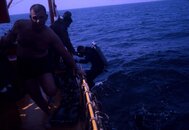I include this scenario (slipped tank) in my Rescue courses. It's pretty common, I've lost count of the times I've assisted a diver with a slipped tank.
You realize that you have identified a product safety issue that DEMA should address with industry standards. I am old enough (turning 65 in a week) and far enough back (started diving in 1959) to say that this did not happen in the older days of diving. But it is no coincident that
DEMA changed its name from the Diving Equipment Manufacturer's Association to the Diving Equipment and Marketing Association. It has no teeth, so we get manufacturers who make products which can easily (apparently) have this "slipped tank" problem. Not only did this not happen in the past,
it could not happen in the past. We had medal bands which took a wrench to take off holding the tank to the harness.
I do not dive current equipment; I am a vintage diver, and can say that this type of incident cannot occur with any equipment that I currently own.
So rather than talking about how the diver should cope with this through training, we should be figuring out why the diving industry has allowed this to occur, and put into place a root causes analysis with action items which will preclude it from happening in the future.
Concerning training, when we look at the
Hierarchy of Controls for incident prevention, these are administrative controls and PPE (personal protective equipment). This is the lowest in priority in the Hierarchy of Controls, meaning that they are the least effective. This is actually shown in this particular incident to be true too. We need to be looking at engineering controls, and substitution. Why do we allow a Velcro attachment prone to failure on a piece of life support equipment? Take a look at the photos below from my Pararescue days; can you imagine what could have happened if a "tank slipped" during a parascuba jump?
In the semiconductor business, we go through a process of accident analysis which we call the "Five Whys" process; it can be applied to any accident/incident situation. Basically, start asking "why" five times, in three different areas
The Incident
1. Why did he have to surface? His tanks slipped.
2. Why did the tank slip? Because it was not checked correctly prior to the dive.
3. Why was it not checked? Because the dive charter hurried through the pre-dive process.
4. Why did the dive charter hurry through the pre-dive process? Unknown, needs further investigation.
5. Why did the diver not check his/her gear? Because the authority, the boat dive master, encouraged them not to.
The Process
1. Why did the process allow this to happen? It was considered "norm" for this boat.
2. Why did the buddies not see the problem, and conduct routine buddy checks? This goes back to the charter and the dive master. They set the "culture" for the dive.
3. Why did the diver allow this dive master to set this kind of culture? Because the diver was new, and not very well trained in his basic course (apparently).
4. Why could the diver/buddy not handle this situation underwater? The buddy system broke down with the excitement of the exploration, and the buddy system went away. This became a group dive with no one watching out for the other guy.
5. Why was this not covered in the diver's training? Unknown.
The Equipment
1. Why did the tank slip? Because the Velcro was not tight.
2. Why was the Velcro attachment not tight? Because the diver, the dive master, the dive equipment maintenance person, all missed checking the attachment.
3. Why was this type of attachment allowed to be used in a life support system? It has become "normal" in the dive industry so that it is convenient to change tanks quickly.
4. Why is there no "fail-safe" mode for this attachment? It was not designed in at the manufacturer's level.
5. Why is this kind of oversight allowed within the diving industry? There apparently are no industry standards for the diving industry, such as is seen in other industries (
SEMI being notable here).
From this information, Action Items can be developed with assigned personnel, dates, etc. to implement changes.
There is one other point to be made here. Many people who dive now do not consider surfacing a viable option due to their orientation to "overhead environments" (an older term we used in the 1980s to define any diving situation where we could not surface for some reason). Technical divers dive in a manner to assume an overhead environment, either by going through/under obstructions (caves and caverns), wreck diving, ice diving, or deep diving with decompression (where nitrogen loading precludes a direct ascent to the surface). These used to be considered specialty diving, but more and more are becoming the norm. But surfacing is a viable option in many (if not most) diving situations which used to be considered "normal" to diving (no decompression diving, for instance).
SeaRat





